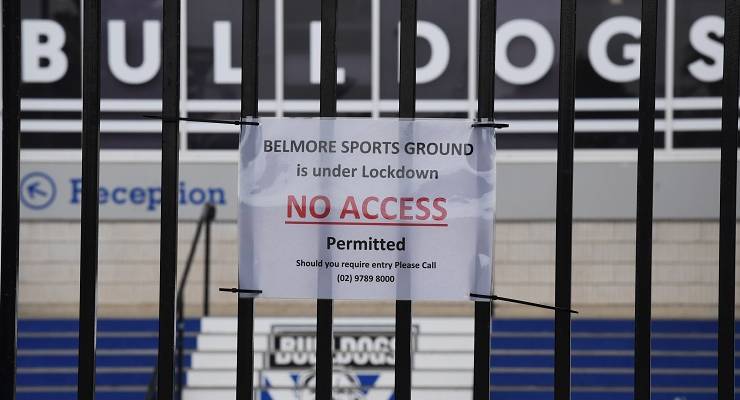
Not for the first time, rugby league has tumbled headfirst into the centre of Australia’s media wars, and found itself a key talking point in the country’s open-or-shut public health debate.
In the short term, it’s given us the Easter spectacle of the Peter Costello-chaired Nine going all Occupy Wall Street over the NRL’s executive pay. In the longer term, it’s opened a window into what looks like being a more challenging (and probably poorer) professional sports sector as so-called over-the-top streaming weakens free-to-air television.
As advertising has collapsed, Nine wants broadcast sport to stay shut — and for the broadcast rights to be cheaper in the future. On the other hand, Foxtel needs sport to anchor its falling pay TV audience and to pull off its diversification into sports streaming through Kayo.
Both are hard-headed calculations for companies struggling to survive the COVID-19 shock, reflecting the competing commercial imperatives of advertising-supported and user-supported media.
Rugby league fans have been watching this bubbling along since late March, thrilling at the pot-shots from the trenches by Nine columnists and commentators, while mourning the game’s absence with the writers at News Corp.
Meanwhile, News Corp has been continuing its campaign against Rugby Union (and CEO Raelene Castle) over the code’s decision to explore broadcast and digital rights beyond the Foxtel offering.
Union’s sin is to be tempted more by, say, the $63 million a year Optus is paying the English Premier League to stream games, rather than the mid-$30 million that Foxtel is reported to be offering for broadcast rights. (“Gluttony” according to Alan Jones in his Easter message in The Weekend Australian. “Rah Rah Rabble” huffed The Sunday Telegraph.)
On Thursday morning, Nine blew the NRL fight into the open, attacking the code for mismanagement with a “bloated” head office. The NRL responded that afternoon by announcing a targeted resume date of May 28 (“FREE TO PLAY” screamed The Sunday Telegraph).
Over the weekend, the two companies took to the fight as though from parallel universes. In a battle of the Phils, Phil “Gus” Gould wrote in Nine’s Sun-Herald that Nine’s intervention was “timely and appropriate”. Phil “Buzz” Rothfield countered in the next day’s Telegraph that Nine was “trying to kick rugby league while it’s down”.
Who needs the players when the fight over the game provides more than enough spectacle?
But at its heart lies a deeper threat. Nine is trying to pivot away from “the home of sport” that Kerry Packer embedded into its DNA. Case in point: the end of a 40-year connection with cricket in 2018 when the company declined to match a boosted Seven-Foxtel offer.
Free-to-airs expect sports rights to pay for themselves, taking value from the halo effect of ratings wins and the confidence that the sports audiences will stick around for the rest of the schedule. Now, Nine seems to be thinking: “Not so much.”
Nine says it’s already saved this year’s rights payment in its “Operational Initiatives” advice to the Australian Stock Exchange on March 30. At $130 million, that’s about half of all the savings it’s identified. To put it in perspective, on its own, it’s more than 10% of their annual pre-COVID-19 revenues. If the NRL season resumes without the advertising it would normally bring, Nine will need to find those savings elsewhere.
Sports rights in Australia are at record highs. The increased competition for our eyeballs — streaming services, pay TV and free-to air — has pushed up prices as new entrants try to get a foothold, and old players try desperately to hang on.
Inevitably, AFL-dominated media will dismiss the story with a “that’s rugby league” shrug as the ABC’s Offsiders did on Sunday morning. But both rugby codes suggest that broadcast deals have peaked. Sports will need to better exploit streaming and digital options — perhaps in their own right — or make do with less.
We’ve been here before. The Murdoch-Packer fight over the code in the 1990s Super League wars set the guardrails for all sports in handling the introduction of pay television in Australia. Equally, the current battle will shape the role of professional sport in the post-COVID-19 streaming-dominated media landscape.








Crikey is committed to hosting lively discussions. Help us keep the conversation useful, interesting and welcoming. We aim to publish comments quickly in the interest of promoting robust conversation, but we’re a small team and we deploy filters to protect against legal risk. Occasionally your comment may be held up while we review, but we’re working as fast as we can to keep the conversation rolling.
The Crikey comment section is members-only content. Please subscribe to leave a comment.
The Crikey comment section is members-only content. Please login to leave a comment.